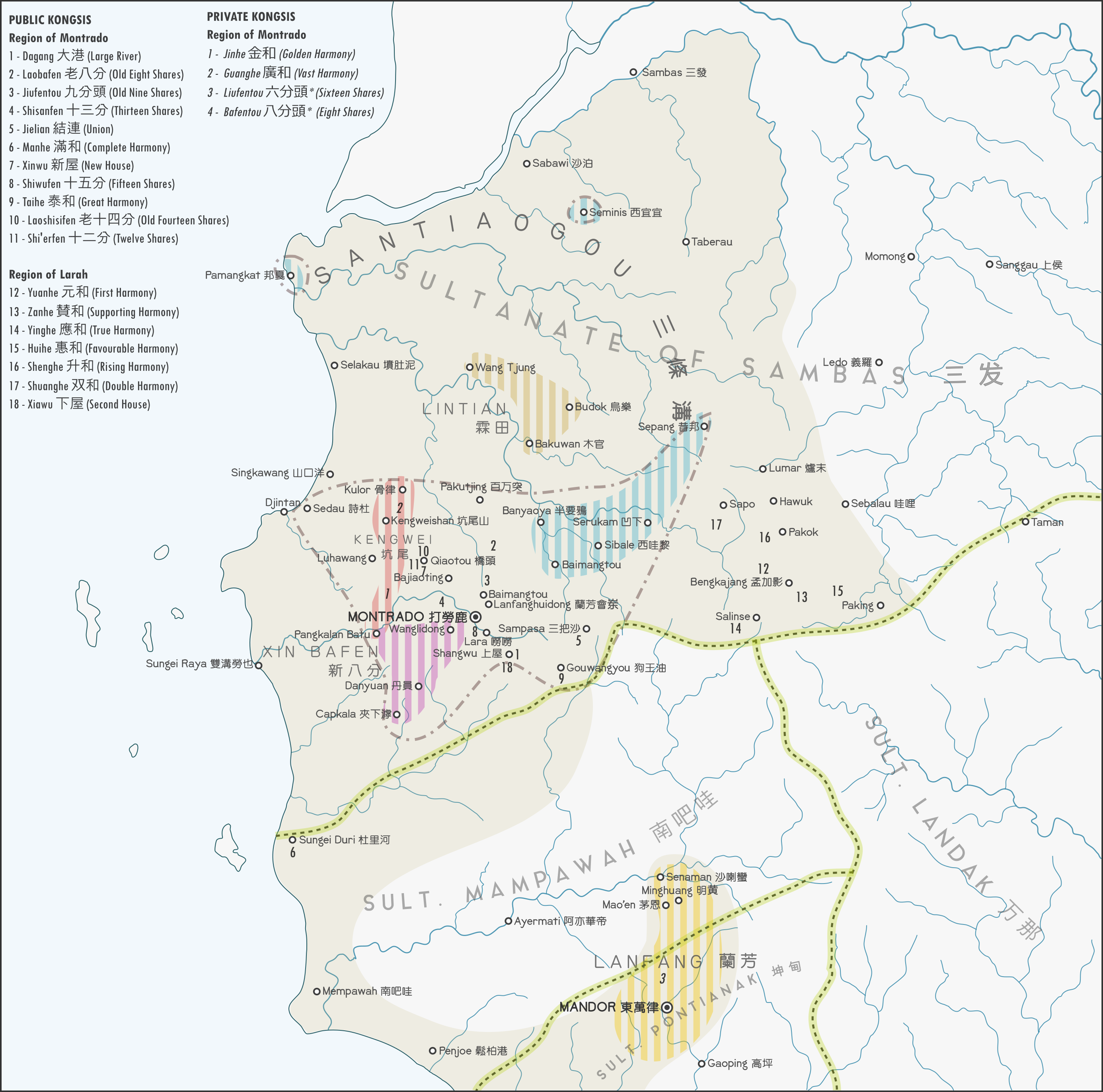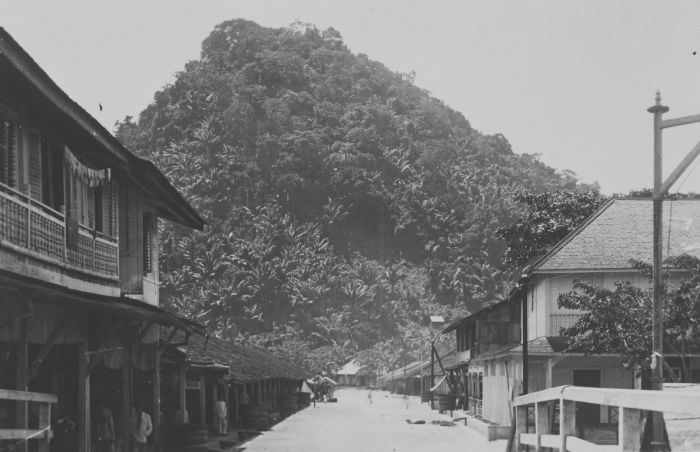|
Santiaogou Republic
The Santiaogou Republic ( zh, 三條溝公司, Hakka Chinese, Hakka/Dutch language, Dutch: Sam-Thiao-Keoe; "Three gullies"), sometimes spelled as Santiago Republic in some sources, later renamed as the Sanda Futing (Chinese language, Chinese: 三達副廳; "Deputy Hall of Three Reaches"), and lastly as the Hexian Zhengting (Chinese language, Chinese: 和現正廳; "Legitimate Parliament of the Harmonies Present"), was a powerful Chinese Kongsi republic, kongsi federation formerly associated with Monterado, Bengkayang, Monterado (Chinese language, Chinese: 打勞鹿, Hakka Chinese, Hakka: Montradok) district before moving to Sepang (town), Sepang (Chinese language, Chinese: 昔邦, Hakka Chinese, Hakka: Sapawang) in West Kalimantan, Borneo. It joined the Heshun Confederation in 1776, but left due to disputes and allied with the sultan of Sultanate of Sambas, Sambas (and later the Dutch East India Company, Dutch), succeeding in destroying its former ally Heshun and the Dagang kongsi. ... [...More Info...] [...Related Items...] OR: [Wikipedia] [Google] [Baidu] |
Hakka Chinese
Hakka ( zh, c=, p=Kèjiāhuà; '' Pha̍k-fa-sṳ: '', zh, c=, p=Kèjiāyǔ; '' Pha̍k-fa-sṳ: '') forms a language group of varieties of Chinese, spoken natively by the Hakka people in parts of Southern China, Taiwan, some diaspora areas of Southeast Asia and in overseas Chinese communities around the world. Due to its primary usage in isolated regions where communication is limited to the local area, Hakka has developed numerous varieties or dialects, spoken in different provinces, such as Guangdong, Guangxi, Hainan, Fujian, Sichuan, Hunan, Jiangxi, Guizhou, as well as in Taiwan, Singapore, Malaysia, Thailand and Indonesia. Hakka is not mutually intelligible with Yue, Wu, Min, Mandarin or other branches of Chinese, and itself contains a few mutually unintelligible varieties. It is most closely related to Gan and is sometimes classified as a variety of Gan, with a few northern Hakka varieties even being partially mutually intelligible with southern Gan. There is also ... [...More Info...] [...Related Items...] OR: [Wikipedia] [Google] [Baidu] |
Guangdong
) means "wide" or "vast", and has been associated with the region since the creation of Guang Prefecture in AD 226. The name "''Guang''" ultimately came from Guangxin ( zh, labels=no, first=t, t= , s=广信), an outpost established in Han dynasty near modern Wuzhou, whose name is a reference to an order by Emperor Wu of Han to "widely bestow favors and sow trust". Together, Guangdong and Guangxi are called ''Liangguang, Loeng gwong'' ( zh, labels=no, first=t, t=兩廣, s=两广 , p=liǎng guǎng) During the Song dynasty, the Two Guangs were formally separated as ''Guǎngnán Dōnglù'' ( zh, first=t, t=廣南東路, s=广南东路, l=East Circuit (administrative division), Circuit in Southern Guang , labels=no) and ''Guǎngnán Xīlù'' ( zh, first=t, t=廣南西路, s=广南西路, l=West Circuit (administrative division), Circuit in Southern Guang , labels=no), which became abbreviated as ''Guǎngdōng Lù'' ( zh, first=t, t=廣東路, s=广东路 , labels=no) and ''Guǎngxī Lù ... [...More Info...] [...Related Items...] OR: [Wikipedia] [Google] [Baidu] |
Great Wall Of China
The Great Wall of China (, literally "ten thousand ''li'' long wall") is a series of fortifications in China. They were built across the historical northern borders of ancient Chinese states and Imperial China as protection against various nomadic groups from the Eurasian Steppe. The first walls date to the 7th century BC; these were joined together in the Qin dynasty. Successive dynasties expanded the wall system; the best-known sections were built by the Ming dynasty (1368–1644). To aid in defense, the Great Wall utilized watchtowers, troop barracks, garrison stations, signaling capabilities through the means of smoke or fire, and its status as a transportation corridor. Other purposes of the Great Wall have included border controls (allowing control of immigration and emigration, and the imposition of duties on goods transported along the Silk Road), and the regulation of trade. The collective fortifications constituting the Great Wall stretch from Liaodong in ... [...More Info...] [...Related Items...] OR: [Wikipedia] [Google] [Baidu] |
Stockade
A stockade is an enclosure of palisades and tall walls, made of logs placed side by side vertically, with the tops sharpened as a defensive wall. Etymology ''Stockade'' is derived from the French word ''estocade''. The French word was derived from the Spanish word ''estacada''. As a security fence The troops or settlers would build a stockade by clearing a space of woodland and using the trees whole or chopped in half, with one end sharpened on each. They would dig a narrow trench around the area, and stand the sharpened logs side-by-side inside it, encircling the perimeter. Sometimes they would add additional defence by placing sharpened sticks in a shallow secondary trench outside the stockade. In colder climates sometimes the stockade received a coating of clay or mud that would make the crude wall wind-proof. Builders could also place stones or thick mud layers at the foot of the stockade, improving the resistance of the wall. From that the defenders could, if they had the ... [...More Info...] [...Related Items...] OR: [Wikipedia] [Google] [Baidu] |
Lara (Kalimantan)
Lara may refer to: People * Lara (name), can be a given name or a surname in several languages * Lara (mythology), a naiad nymph, daughter of the river Almo in Ovid's ''Fasti'' Places *Lara (state), a state in Venezuela *Electoral district of Lara, an electoral district in Victoria, Australia *Lara, Antalya, an urban district in Turkey *Lara, Victoria, a township in Australia **Lara railway station *Lara de los Infantes, a place in Spain *Punta Lara, a city in Buenos Aires Province, Argentina *LARA, the airport code for Jacinto Lara International Airport, in Barquisimeto, Venezuela Art, entertainment, and media * ''Lara'' (film), 2019 film * Lara (character), the biological mother of the comic book character Superman * Lara (novel), 1997 novel-in-verse by Bernardine Evaristo * Lara & Reyes, an instrumental band * ''Lara's Theme'', the generic name given to a leitmotif written for the film ''Doctor Zhivago'' (1965) by composer Maurice Jarre * ''Lara, A Tale'' (1814), a poem ... [...More Info...] [...Related Items...] OR: [Wikipedia] [Google] [Baidu] |
Kongsi Map
Kongsi () is a Hokkien transcription of a Chinese term meaning "company", especially businesses which have been Incorporation (business), incorporated. However, the word has other meanings under different historical contexts. ''Kongsi'' were most commonly known as Chinese social organizations or partnerships, but the term was also used for various Chinese institutions. Amongst overseas Chinese, the word ''kongsi'' was applied to reference both clan organizations, whose members shared a common descent, and to district-dialect clubs, for Chinese immigrants originating from the same district speaking the same dialect. In the late 19th century, these district-dialect associations came to be known as ''wui gun'' (''huiguan''; ), especially in San Francisco, California where many Chinese from eight districts on the west side of the Pearl River Delta near the City of Guangzhou, Canton went for the California gold rush. Southeast Asia In Southeast Asia, the kongsi republics were made ... [...More Info...] [...Related Items...] OR: [Wikipedia] [Google] [Baidu] |
Pamangkat
Pemangkat (Chinese: 邦戛, Pinyin: Bāngjiá) is a coastal town at the mouth of the Sambas River in West Kalimantan, Indonesia. It is located to the northwest of the provincial capital Pontianak, and had 54,048 inhabitants in mid 2024.Badan Pusat Statistik, 2025. Demographic Most of the Pemangkat population are Malay and Tionghoa. The natives of Pemangkat are commonly referred to in Hakka language Hakka ( zh, c=, p=Kèjiāhuà; ''Pha̍k-fa-sṳ: '', zh, c=, p=Kèjiāyǔ; ''Pha̍k-fa-sṳ: '') forms a language group of varieties of Chinese, spoken natively by the Hakka people in parts of Southern China, Taiwan, some diaspora areas of ... as Pangkatnyin, meaning people of Pemangkat. Geography Pemangkat has a famous temple, , which is located on the Elephant mount (). This temple is a worship place to a god whom local Chinese believe to be protecting fishermen when sailing out on the sea. This small town still practices many traditional Chinese cultures which can rarel ... [...More Info...] [...Related Items...] OR: [Wikipedia] [Google] [Baidu] |
Seminis (Kalimantan)
Seminis is a developer, grower, and marketer of fruit and vegetable seeds, currently a subsidiary of Bayer. Seminis' hybrids claim to improve nutrition, boost crop yields, limit spoilage and reduce the need for chemicals. Their retail line includes over 3,500 seed varieties. History Seminis was established in 1994 by Alfonso Romo under his Savia Group, a part of the Empresas La Moderna S.A. conglomerate, to consolidate leading companies in the fragmented fruit and vegetable seed industry. The goal was realized by takeovers of several companies, including Asgrow, Petoseed, Royal Sluis, Bruinsma Seeds, and Genecorp. In 1996, Romo sold the field crop business of Seminis to Monsanto for $240 million. In 1999, Savia took Seminis public, in which Savia retained control of the company. In September 2003, Savia took Seminis off the public markets for approximately $650 million via an investment of approximately $222 million from Fox Paine & Company and additional cash and stock from ... [...More Info...] [...Related Items...] OR: [Wikipedia] [Google] [Baidu] |



